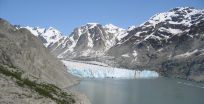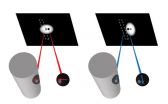(Press-News.org) CORVALLIS, Ore. - Incessant mountain rain, snow and melting glaciers in a comparatively small region of land that hugs the southern Alaska coast and empties fresh water into the Gulf of Alaska would create the sixth largest coastal river in the world if it emerged as a single stream, a recent study shows.
Since it's broken into literally thousands of small drainages pouring off mountains that rise quickly from sea level over a short distance, the totality of this runoff has received less attention, scientists say. But research that's more precise than ever before is making clear the magnitude and importance of the runoff, which can affect everything from marine life to global sea level.
The collective fresh water discharge of this region is more than four times greater than the mighty Yukon River of Alaska and Canada, and half again as much as the Mississippi River, which drains all or part of 31 states and a land mass more than six times as large.
"Freshwater runoff of this magnitude can influence marine biology, nearshore oceanographic studies of temperature and salinity, ocean currents, sea level and other issues," said David Hill, lead author of the research and an associate professor in the College of Engineering at Oregon State University.
"This is an area of considerable interest, with its many retreating glaciers," Hill added, "and with this data as a baseline we'll now be able to better monitor how it changes in the future."
The findings were reported in the Journal of Geophysical Research: Oceans, by Hill and Anthony Arendt at the University of Alaska-Fairbanks. It was supported by the North Pacific Research Board.
This is one of the first studies to accurately document the amount of water being contributed by melting glaciers, which add about 57 cubic kilometers of water a year to the estimated 792 cubic kilometers produced by annual precipitation in this region. The combination of glacial melt and precipitation produce an amount of water that's larger than many of the world's great rivers, such as the Ganges, Nile, Volga, Niger, Columbia, Danube or Yellow River.
"By combining satellite technology with on-the-ground hydraulic measurements and modeling, we're able to develop much more precise information over a wider area than ever before possible," Hill said.
The data were acquired as an average of precipitation, glacial melting and runoff over a six-year period, from 2003 to 2009. Knocked down in many places by steep mountains, the extraordinary precipitation that sets the stage for this runoff averages about 6 feet per year for the entire area, Hill said, and more than 30 feet in some areas.
The study does not predict future trends in runoff, Hill said. Global warming is expected in the future, but precipitation predictions are more variable. Glacial melt is also a variable. A warmer climate would at first be expected to speed the retreat of existing glaciers, but the amount of water produced at some point may decrease as the glaciers dwindle or disappear.
Additional precision in this study was provided by NASA's Gravity Recovery and Climate Experiment, or GRACE satellites, which can make detailed measurements of gravity and, as one result, estimate the mass of glaciers they are flying over. As the glacial mass decreases over time, the amount of melted water that was produced can be calculated.
The close agreement of land-based measurements also help confirm the accuracy of those made from space, a point that will be important for better global understanding of water stored in a high-altitude environment.
Some of the processes at work are vividly illustrated at Glacier Bay National Park, where some of the most rapidly retreating glaciers in the world are visited each year by hundreds of thousands of tourists, many on cruise ships.
INFORMATION:
Both patients and physicians may benefit from a "work flow" system developed at military medical facilities and tested at a Johns Hopkins Kimmel Cancer Center clinic, according to results of an efficiency study.
The study evaluates a work flow method developed by the U.S. Air Force; Johns Hopkins researchers Shereef Elnahal, M.D., M.B.A. and Joseph Herman, M.D.; and consulting firm ProcessProxy Corporation. Called the Military Acuity Model, the method examines tasks performed by physicians and nurses and identifies jobs that can be safely assigned to support staff. For ...
By genomic sequencing of leukemia cells from relapsed patients at different stages, scientists have discovered key details of how acute lymphoblastic leukemia (ALL) cells mutate to survive chemotherapy. These mutations enable the cells to proliferate, causing relapse and often death.
The findings are important because ALL is a leading cause of cancer deaths in children, with 15 percent of ALL patients relapsing with poor survival. The researchers said their findings will lead to new tests to monitor children in remission and to detect signs of relapse.
The research ...
Without better local management, the world's most iconic ecosystems are at risk of collapse under climate change, say researchers in Science. Protecting places of global environmental importance such as the Great Barrier Reef and the Amazon rainforest from climate change will require reducing the other pressures they face, for example overfishing, fertilizer pollution or land clearing.
The international team of researchers warns that localized issues, such as declining water quality from nutrient pollution or deforestation, can exacerbate the effects of climatic extremes, ...
March 19, 2015--(Bronx, NY)--Scientists at Albert Einstein College of Medicine of Yeshiva University and their international collaborators have developed a novel fluorescence microscopy technique that for the first time shows where and when proteins are produced. The technique allows researchers to directly observe individual messenger RNA molecules (mRNAs) as they are translated into proteins in living cells. The technique, carried out in living human cells and fruit flies, should help reveal how irregularities in protein synthesis contribute to developmental abnormalities ...
Prosthetics with a realistic sense of touch. Bridges that detect and repair their own damage. Vehicles with camouflaging capabilities.
Advances in materials science, distributed algorithms and manufacturing processes are bringing all of these things closer to reality every day, says a review published today in the journal Science by Nikolaus Correll, assistant professor of computer science, and research assistant Michael McEvoy, both of the University of Colorado Boulder.
The "robotic materials" being developed by Correll Lab and others are often inspired by nature, ...
Biologists at the University of California, San Diego have developed a new method for generating mutations in both copies of a gene in a single generation that could rapidly accelerate genetic research on diverse species and provide scientists with a powerful new tool to control insect borne diseases such as malaria as well as animal and plant pests.
Their achievement was published today in an advance online paper in the journal Science. It was accomplished by two biologists at UC San Diego working on the fruit fly Drosophila melanogaster who employed a new genomic technology ...
Berkeley -- Scientists at the University of California, Berkeley, have identified a new molecular pathway critical to aging, and confirmed that the process can be manipulated to help make old blood like new again.
The researchers found that blood stem cells' ability to repair damage caused by inappropriate protein folding in the mitochondria, a cell's energy station, is critical to their survival and regenerative capacity.
The discovery, to be published in the March 20 issue of the journal Science, has implications for research on reversing the signs of aging, a process ...
Without better local management, the world's most iconic ecosystems are at risk of collapse under climate change, say researchers in a study published in the journal Science.
The international team of researchers say protecting places of global environmental importance such as the Great Barrier Reef and the Amazon rainforest from climate change requires reducing the other pressures they face, for example overfishing, fertilizer pollution or land clearing.
The researchers warn that localised issues, such as declining water quality from nutrient pollution or deforestation, ...
The 2014 chemistry Nobel Prize recognized important microscopy research that enabled greatly improved spatial resolution. This innovation, resulting in nanometer resolution, was made possible by making the source (the emitter) of the illumination quite small and by moving it quite close to the object being imaged. One problem with this approach is that in such proximity, the emitter and object can interact with each other, blurring the resulting image. Now, a new JQI study has shown how to sharpen nanoscale microscopy (nanoscopy) even more by better locating the exact ...
Sifting through the center of the Milky Way galaxy, astronomers have made the first direct observations - using an infrared telescope aboard a modified Boeing 747 - of cosmic building-block dust resulting from an ancient supernova.
"Dust itself is very important because it's the stuff that forms stars and planets, like the sun and Earth, respectively, so to know where it comes from is an important question," said lead author Ryan Lau, Cornell postdoctoral associate for astronomy, in research published March 19 in Science Express. "Our work strongly reinforces the theory ...




